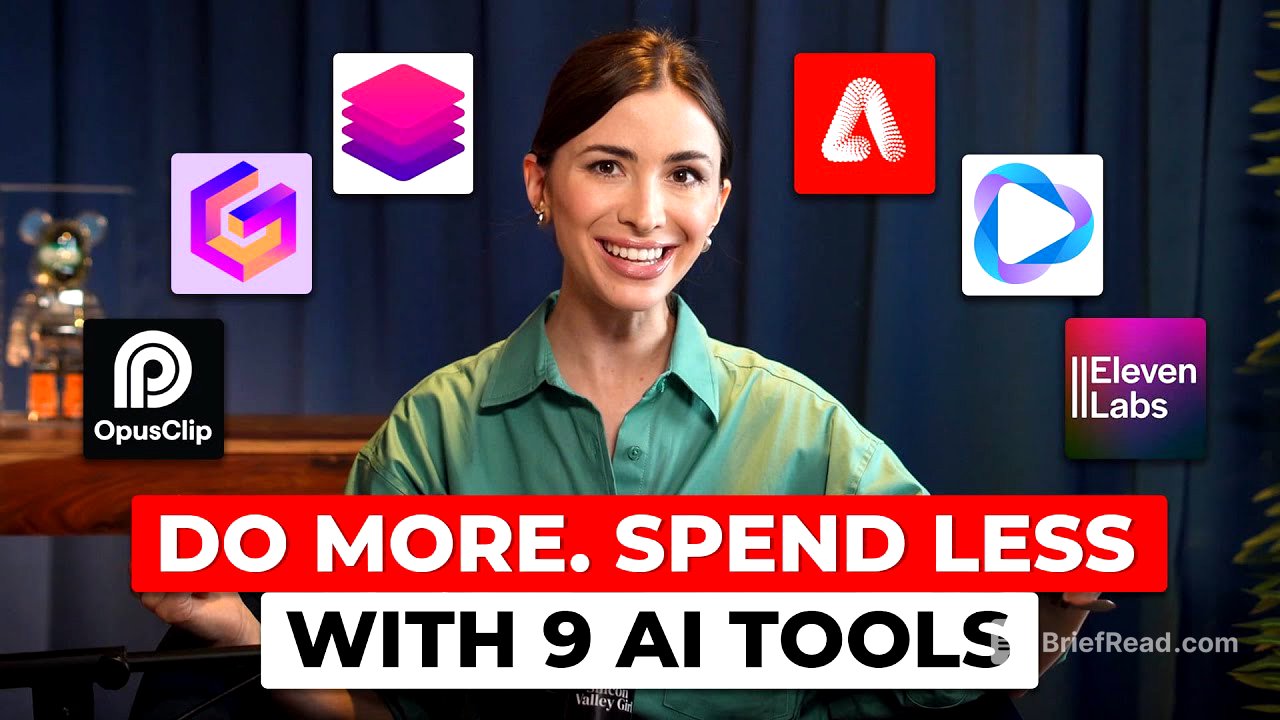TLDR;
The video discusses how AI is transforming the way we live, work, and create, presenting it as a significant opportunity for solo founders and content creators in 2025. It highlights nine AI tools used by the speaker's team to save time and money across content creation, sales, and operations. The tools range from those that automate social media posts and generate viral video clips to those that streamline hiring processes and enhance team collaboration.
- AI is now multimodal, proactive, personal, and powerful.
- 2025 is the best year to start as a solo founder or creator due to the availability of AI tools.
- AI helps in content creation, sales, and business operations.
Why Now Is the Best Time for AI [0:00]
The speaker shares her experience from Google IO, emphasizing the transformative impact of AI. AI is described as multimodal, understanding voice, images, code, and text, and evolving to be proactive and personal. The focus is shifting from writing prompts to using tool calls for actions like sending emails and summarizing meetings. The speaker underscores that those who start experimenting with AI now will gain a significant advantage, referencing a friend's company that experienced rapid growth using AI.
Tool 1: Monica + Custom GPT Agents [3:02]
The speaker introduces Monica, a Chrome extension used with custom GPT agents to enhance productivity. Monica is used across platforms like Gmail, LinkedIn, and Notion for tasks such as summarizing pages and drafting documents. Custom GPTs are trained with specific information, including the speaker's tone of voice and preferences, to personalize AI responses. This setup enables the team to create content in the speaker's style without direct input, facilitating quick contract reviews, customer emails, and social media posts.
Tool 2: ChatPDF + ChatGPT (for Contracts & Hiring) [4:18]
ChatPDF combined with ChatGPT is used to streamline contract reviews and hiring processes. Legal documents and contracts are uploaded to ChatPDF, and ChatGPT is used to identify red flags, rewrite clauses, and summarize content. Voice notes are used to provide instructions to AI, which then drafts partner emails. This approach has accelerated the hiring process by five times while maintaining consistency.
Tool 3: Opus Clip, Gamma, EasyGen/Claude AI (for Content) [6:14]
The speaker highlights the concept of infinitely remixable content, using tools like Opus Clip, Gamma, and EasyGen/Claude AI. Opus Clip repurposes long-form videos into short clips for platforms like Instagram, TikTok, and LinkedIn. Gamma is used to design presentations and visuals for course materials and video explainers. EasyGen or Claude AI assists in generating high-performing hooks and posts for LinkedIn, which has significantly grown in popularity. The copywriter uses EasyGen to create posts that achieve high engagement in a short amount of time.
Tool 4: Otter, Copilot [8:18]
Otter and Copilot are used for team synchronization and feedback loops. These tools automatically generate action items from meeting transcriptions, analyze sentiment, and suggest follow-ups. This ensures that no ideas are dropped and that team members can stay informed even if they miss a meeting. The speaker also records conference talks using an Apple Watch and converts the audio to text using Otter, then uses GPT to create LinkedIn posts.
Tool 5: Trint, 11Labs, HeyGen [9:57]
Trint, 11Labs, and HeyGen are used for content localization and multimedia production. Trint transcribes video and audio files, allowing editors to work directly within the interface. 11Labs clones the speaker's voice for Russian and English voiceovers, reducing the cost of hiring voice actors. HeyGen is used to generate dubbed or translated videos, handling lip sync, subtitles, and avatars. This stack was used to translate an interview with Reed Hoffman into Russian, resulting in significant views.
Tool 6: Gong.io/Chorus.ai + Tableau/Power BI [11:19]
Gong.io or Chorus.ai, combined with Tableau or Power BI, is used to enhance sales performance. Chorus AI and Gong IO analyze sales calls and client conversations, detecting tone, keywords, and sentiment to provide feedback. Tableau or Power BI is integrated with the CRM to track results, visualize trends, and provide real-time data. The sales team uses Gong to understand deal outcomes and Tableau to report weekly results without manual spreadsheets.
Tool 7: Gemini for Google Sheets [12:10]
Gemini for Google Sheets is used to summarize form responses, analyze data, and generate formulas. The team uses it to sort student feedback, summarize onboarding notes, and create images with Imagen. This tool enhances data analysis within spreadsheets.
Tool 8: Adobe Firefly + AI in Photoshop [12:39]
Adobe Firefly and AI in Photoshop are used to automate and enhance thumbnail design. Tasks such as background removal, color matching, and adding visual elements are streamlined with AI. The designer uses ChatGPT to brainstorm visual styles, saving time and enabling more creative freedom.
Tool 9: Notebook LM, Veo, Google Meet [13:29]
Notebook LM, Veo, and Google Meet are presented as futuristic tools. Notebook LM turns documents, slides, and notes into podcast-style conversations. Veo generates synchronized audio and visual content, including realistic speech and environmental sounds. Google Meet offers real-time speech translation between languages, facilitating global team collaboration.
Final Tips & Takeaways [16:43]
The video concludes by emphasizing that the use of AI is not just about saving time but about creating space for thinking and building. The speaker reiterates that it is still early in the AI revolution and encourages viewers to start experimenting with these tools.
